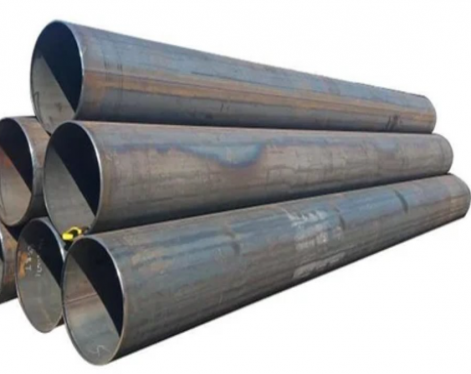Hydraulic test is a method to detect the defects of SSAW steel pipe, which is widely used in the inspection of various pressure steel pipes.When the steel pipe is subjected to the hoop tensile stress during the hydrostatic pressure test, if the performance of the steel pipe does not meet the requirements or has defects, it will bend, crack, crack and release pressure under the action of the tensile stress, fully exposing the defects. Therefore, the hydrostatic pressure test can have a better inspection effect on the external defects of the steel pipe.
Calculation formula for hydrostatic test
P=2ST/D
(P: test pressure, unit Mpa, 1Mpa=10kg; S: test stress; T: wall thickness; D: pipe diameter)
The operation process of the hydrostatic test
1. Before the test, check whether the water pump and oil pump system are normal, and whether the control system is normal
2. After adding the steel pipe to be tested to the sealing rubber ring, send it into the hydraulic press.
3. Start the trusteeship and lightly push the steel pipe against the cylinder head, start the oil pump and push the oil pump to seal both ends of the steel pipe, and turn on the low-pressure water pump to inject water into the pipe. Pay attention to the air in the drainage area, and close it after the water flows out, and turn on the high-pressure water pump to increase the pressure to the rated pressure. .
4. After the pressure is stabilized, check all the welds of the steel pipe for leakage.
5. After the inspection, the booster system stops working, and the main oil cylinder is decompressed and water is released.
6. Drop the idler, and push the steel pipe out of the hydraulic press after inspecting the steel pipe.
7. Special attention should be paid to the pressure test of the steel pipe. The pressure value of the oil pressure gauge and the water pressure gauge must meet the standard requirements, and the pressure gauge should be calibrated according to the appraisal cycle.

Main technical parameters of SSAW pipe hydrostatic test:
1. Applicable media: most hydraulic media such as water and hydraulic oil
2. Suitable temperature: -45℃~120℃
3. Driving power: compressed air (below 0.7MPa, 1Nm3/min)
4. Pressure range: 0-700MPa, (common pressure range 0-700MPa)
5. Pressure accuracy: ±1%F.S
6. Flow range: 0~40L/min
7. Stepless adjustment of pressure can be realized
8. The whole system adopts non-welding connection, which is easy to disassemble and reuse, safe and reliable.
Note: Under the test pressure, it should be ensured that the pressure resistance time is not less than 5s, and the steel pipe shall not leak or leak.
The hydraulic test can be replaced by ultrasonic inspection or eddy current inspection. The groove depth of the comparative sample for ultrasonic inspection is 12.5% of the nominal wall thickness of the steel pipe, and the sensitivity of the eddy current inspection is grade A.
The purpose of the hydrostatic test is to test the process pipelines, vessels, heat exchangers or process pipelines and equipment that have been welded due to alterations during maintenance.
In order to ensure the strength of each joint or weld, the device can safely withstand normal operating pressure.
Calculation formula for hydrostatic test
P=2ST/D
(P: test pressure, unit Mpa, 1Mpa=10kg; S: test stress; T: wall thickness; D: pipe diameter)
The operation process of the hydrostatic test
1. Before the test, check whether the water pump and oil pump system are normal, and whether the control system is normal
2. After adding the steel pipe to be tested to the sealing rubber ring, send it into the hydraulic press.
3. Start the trusteeship and lightly push the steel pipe against the cylinder head, start the oil pump and push the oil pump to seal both ends of the steel pipe, and turn on the low-pressure water pump to inject water into the pipe. Pay attention to the air in the drainage area, and close it after the water flows out, and turn on the high-pressure water pump to increase the pressure to the rated pressure. .
4. After the pressure is stabilized, check all the welds of the steel pipe for leakage.
5. After the inspection, the booster system stops working, and the main oil cylinder is decompressed and water is released.
6. Drop the idler, and push the steel pipe out of the hydraulic press after inspecting the steel pipe.
7. Special attention should be paid to the pressure test of the steel pipe. The pressure value of the oil pressure gauge and the water pressure gauge must meet the standard requirements, and the pressure gauge should be calibrated according to the appraisal cycle.

Main technical parameters of SSAW pipe hydrostatic test:
1. Applicable media: most hydraulic media such as water and hydraulic oil
2. Suitable temperature: -45℃~120℃
3. Driving power: compressed air (below 0.7MPa, 1Nm3/min)
4. Pressure range: 0-700MPa, (common pressure range 0-700MPa)
5. Pressure accuracy: ±1%F.S
6. Flow range: 0~40L/min
7. Stepless adjustment of pressure can be realized
8. The whole system adopts non-welding connection, which is easy to disassemble and reuse, safe and reliable.
Note: Under the test pressure, it should be ensured that the pressure resistance time is not less than 5s, and the steel pipe shall not leak or leak.
The hydraulic test can be replaced by ultrasonic inspection or eddy current inspection. The groove depth of the comparative sample for ultrasonic inspection is 12.5% of the nominal wall thickness of the steel pipe, and the sensitivity of the eddy current inspection is grade A.
The purpose of the hydrostatic test is to test the process pipelines, vessels, heat exchangers or process pipelines and equipment that have been welded due to alterations during maintenance.
In order to ensure the strength of each joint or weld, the device can safely withstand normal operating pressure.









